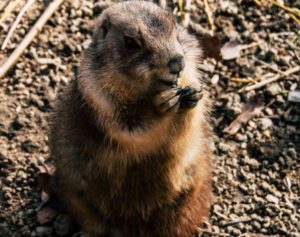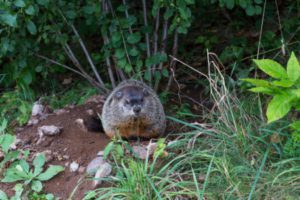ONCE AGAIN, TIME TO CELEBRATE GROUNDHOGS?
By Chris Williams on January 30, 2020.
Since my calendar says there is an annual event called Groundhog Day coming up, it seems like a good time to review the interesting biology of our large, furry friend, the groundhog, also known in our region as the woodchuck.
“PUNXSUTAWNEY PHIL,” OUR RELUCTANT HERO

Punxsutawney Phil eating. Shutterstock.
The reason that poor, dazed Punxsutawney Phil is dragged out of his burrow to put on a show for the media every February is because he is one of the few hibernating animals that will allow the drama. Wouldn’t work so well with a hibernating bear, one thinks. Unlike other urban wildlife such as raccoons or opossums that forage somewhat throughout the winter, groundhogs (and bears) actually become inactive in winter and enter a state of hibernation (see Ban Groundhog Day – Let Those Woodchucks Sleep!).
If you’ve had a woodchuck (groundhog) nesting on your property, you may have seen a lot of activity in the fall as it really chows down to put on fat for winter hibernation. At this time, woodchucks are pretty hard to miss, waddling along on short legs searching for any manner of leftover vegetables or fruit, along with the occasional insects or snails. Since a woodchuck can weigh up to 12 pounds, it can consume a lot of food and can cause a lot of damage to summer gardens.
Burrows are another obvious sign of woodchucks. You can imagine that such a large animal has a large burrow. The main opening can be a foot across and is usually edged with loose dirt. The entire burrow system can be more than 30 feet long and as deep as five feet. The main chamber is lined with grasses where our woodchuck sleeps.
The winter woodchuck has lowered its breathing rate, heart rate, and body temperature, but even so, a hibernating woodchuck can lose 20-30% of its body weight before hibernation ends in late February or early March. Fortunately for famous Phil, even in winter woodchucks may break hibernation once or twice without harm and can be seen briefly foraging outside.
IT’S HARD TO IGNORE EVIDENCE OF WOODCHUCKS

Groundhog sitting at the entry hole of his burrow. Shutterstock.
So, woodchucks – love ‘em or hate ‘em? On the positive side, woodchucks are not aggressive and typically don’t transmit diseases. Their antics can be amusing but we’re not always amused. If it wasn’t for their size, with its accompanying feeding, gnawing, and burrowing damage, we could be tempted to love woodchucks. But, in suburban areas, they tend to burrow under sheds, porches, stonewalls, decks, shrubs, and woodpiles. Their burrowing can undermine foundations and collapsing burrows can topple lawn tractors and break ankles. Besides all that, because they are fastidious enough to have a separate “latrine” chamber inside their burrow system, the burrows tend to smell and attract flies!
CALL A PROFESSIONAL FOR WOODCHUCK REMOVAL
There can also be 4-5 young woodchucks in a female’s burrow in late winter or early spring, so removal of a woodchuck needs to be properly timed. The job should be done by a wildlife specialist licensed and trained in humane removal of nuisance wildlife. At Colonial Pest, we have been removing wildlife for 30 years. If you’re thinking of filling in or destroying the burrow to get the woodchuck to move on, that usually doesn’t work. Give Colonial a call instead.
For more on the lifestyles of our “lovable” woodchucks, see these blogs: